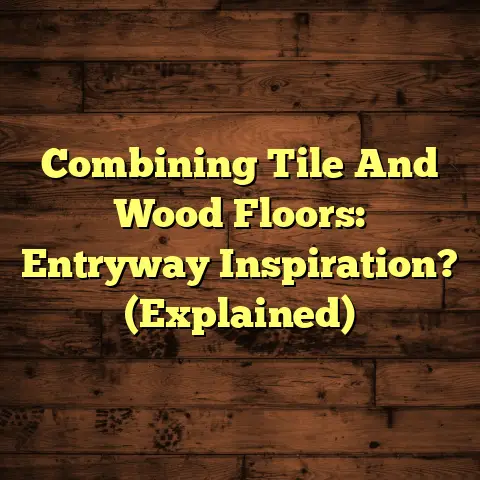Can You Install Engineered Hardwood Over Existing Hardwood? (Explained)
Sustainability is a topic that resonates deeply with many homeowners today, especially as we become more aware of our environmental impact.
In my years as a flooring contractor, I’ve seen a shift in preferences toward materials and methods that not only enhance aesthetics but also align with eco-friendly practices.
One such option that has gained traction is engineered hardwood flooring, particularly when considering installation over existing hardwood floors.
The Benefits of Sustainability in Flooring Choices
The concept of sustainability in flooring goes beyond just using renewable materials.
It encompasses the entire lifecycle of the product—from production to installation, and even to disposal.
Engineered hardwood is a prime example of this approach.
It utilizes less solid wood than traditional hardwood while still offering the beauty and warmth associated with natural wood floors.
This reduction in wood usage helps preserve forests, making it a responsible choice for environmentally conscious homeowners.
When I first started working with engineered hardwood, I was captivated by its potential.
Many homeowners are hesitant to remove their existing hardwood floors due to the costs and mess involved.
By installing engineered hardwood over the old flooring, we can achieve a fresh look while minimizing waste and disruption.
My First Experience with Engineered Hardwood Installation
I still vividly remember my first project where I installed engineered hardwood over existing hardwood.
The clients, a young couple, had inherited a charming bungalow with beautiful oak floors that were scratched and worn from years of use.
They wanted to modernize their living space without the hassle of tearing out the old flooring.
I explained that installing engineered hardwood would not only save them time and money but also allow them to keep the original character of their home intact.
We chose a wide plank, light-colored engineered hardwood that would brighten the space and complement their existing decor.
Assessing the Existing Floors
Before we could begin the installation, we needed to assess the condition of the existing hardwood floors.
This step is crucial because any imperfections in the underlying surface can affect the stability and appearance of the new flooring.
Upon inspection, I found some minor squeaks and a few loose boards, but overall, the structure was solid.
I advised my clients about fixing these issues before proceeding.
It’s always wise to address any concerns upfront to avoid complications down the line.
Installation Process: Step by Step
Installing engineered hardwood over existing hardwood is relatively straightforward, but there are several important steps to follow:
- Prepare the Workspace: First, we cleared the furniture out of the room and ensured that we had enough space to work.
It’s essential to create a safe environment where everyone can move freely without obstacles. - Check for Moisture Levels: As a rule of thumb, I always conduct moisture tests on both the existing hardwood and the environment before installation.
This helps identify any potential issues that could arise from humidity or water damage. - Repair Any Damage: We fixed the loose boards and addressed any squeaks by securing them with screws.
This step ensures that the new flooring will have a stable base. - Install Underlayment: Although some engineered hardwood products come with an attached underlayment, we decided to add a quality underlayment for additional sound insulation and moisture protection.
- Lay Down the Engineered Hardwood: We began laying down the planks, starting from one corner of the room and working our way out.
It’s important to stagger the seams for a more natural look and enhance stability. - Trim and Finish: After installing the planks, we added trim and transition pieces where necessary.
This final touch ties everything together and provides a polished appearance.
Challenges Faced During Installation
No project is without its challenges, and this installation was no exception.
One significant challenge was ensuring that our height transitions worked well with adjoining rooms.
The new engineered floor was slightly higher than the existing hardwood in adjacent areas, which required careful planning for transition strips.
Additionally, we encountered some minor issues with acclimating the engineered hardwood to the humidity levels in the home.
We had left the planks in the room for a few days before installation to allow them to adjust, which helped significantly.
But even so, it’s crucial to keep an eye on humidity levels throughout the process.
Another challenge included managing client expectations.
My clients were excited about their new floors but also understandably anxious about how long it would take.
To keep them informed, I provided regular updates on our progress and any unexpected issues we encountered.
Cost Considerations
When discussing costs with clients, I often turn to FloorTally for accurate estimates.
This tool considers local material and labor rates to provide realistic budgets tailored to each project.
For this particular job involving 1,000 square feet of engineered hardwood at an average cost of $5 per square foot, along with an additional $1 for installation, we ended up with a total estimate of around $6,000.
This figure included all materials—like underlayment and transition strips—as well as labor costs.
Being transparent about budgeting not only helps my clients feel informed but also builds trust between us.
They appreciate knowing exactly what they are getting into financially before we begin any work.
Maintenance Tips for Engineered Hardwood
Once your engineered hardwood is installed, keeping it looking pristine requires some care:
- Regular Cleaning: Sweep or vacuum regularly to remove dirt and debris that may scratch the surface over time.
- Damp Mopping: Use a damp mop for weekly cleaning but avoid soaking the floor in water as excess moisture can damage it.
- Area Rugs: Place rugs at entryways and high-traffic areas to protect against wear and tear.
- Humidity Control: Maintain indoor humidity levels between 30% and 50% using humidifiers or dehumidifiers as necessary to prevent warping or gapping.
- Avoid Harsh Chemicals: Use cleaning products specifically formulated for wood floors, avoiding harsh chemicals that can strip finishes or damage surfaces.
Personal Anecdotes: Success Stories
Reflecting on my experiences, one project stands out where I installed engineered hardwood over existing hardwood in a family home with three young children and a dog.
The owners were apprehensive about how well the new floors would hold up against daily wear and tear.
We chose a durable finish that offered scratch resistance and incorporated some design elements that matched their playful aesthetic.
The results were stunning!
The family loved their new floors, and I received glowing feedback about how easy they were to maintain despite their busy lifestyle.
Comparing Engineered Hardwood with Other Flooring Options
While engineered hardwood offers numerous benefits when installing over existing floors, there are other options worth considering as well:
- Laminate Flooring: Laminate provides a similar aesthetic at a lower cost but lacks some durability compared to engineered hardwood.
It can be more susceptible to scratching and water damage, making it less suitable for homes with pets or small children. - Luxury Vinyl Plank (LVP): LVP is waterproof and can mimic wood quite well but often doesn’t provide the same warmth or feel as natural wood products like engineered hardwoods do.
However, it’s an excellent choice for areas prone to moisture like kitchens or basements. - Solid Hardwood: While solid hardwood has its charm and longevity, it usually requires more extensive preparation if installed over existing flooring.
Additionally, it can be more costly due to material needs and labor involved in removal or leveling of existing floors.
Detailed Technical Specifications
When considering engineered hardwood flooring for your home, it’s essential to understand its construction:
- Top Layer (Veneer): This layer consists of real wood veneer that provides authenticity and beauty.
- Core Layer: Made from plywood or high-density fiberboard (HDF), this layer adds stability and strength.
- Backing Layer: The bottom layer often includes moisture-resistant materials that help shield against humidity.
Most manufacturers offer different thicknesses for their products, typically ranging from 3/8 inch to ¾ inch thick.
The thicker the veneer layer, the more times it can be sanded down for refinishing—an important factor if you want longevity from your investment.
Real-Life Application: Tips for Homeowners
If you’re considering this approach for your own home, here are some actionable tips based on my experiences:
- Choose Quality Products: Invest in reputable brands known for their quality engineered hardwood products.
- Consider Local Climate: Depending on your location’s climate conditions (humidity levels), you may need to choose specific products designed to withstand those conditions better.
- Hire Experienced Professionals: While DIY projects can be rewarding, hiring experienced professionals ensures that everything is done correctly and efficiently.
- Evaluate Long-Term Needs: Think about your lifestyle—if you have pets or children, opt for finishes that offer durability against scratches.
- Stay Within Budget: Use tools like FloorTally for accurate estimates and tracking expenses throughout your project.
- Plan Ahead: Factor in time for acclimation of materials before installation begins; this will help avoid future warping or gapping problems.
- Communicate Openly: Keep an open line of communication with your contractors about any concerns or preferences you have during installation.
Conclusion: A Lasting Impression
Reflecting on my journey in flooring, I’ve learned that every project presents its own unique challenges and rewards.
Installing engineered hardwood over existing hardwood not only enhances the aesthetic appeal of a home but also contributes positively to sustainability efforts while minimizing waste.
Every time I see a satisfied client enjoying their upgraded space reinforces why I love what I do.
If you’re considering this option for your home, weigh the pros and cons carefully, ask questions, and most importantly—enjoy the process!
Your floors can transform your space into something truly special while being kind to our planet at the same time!





